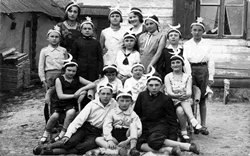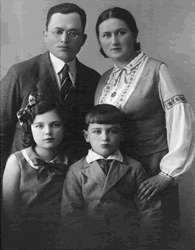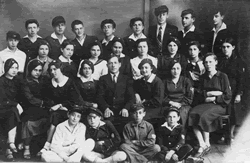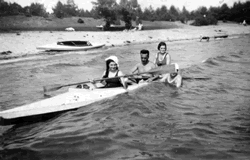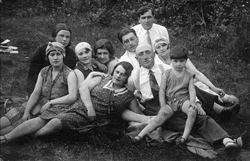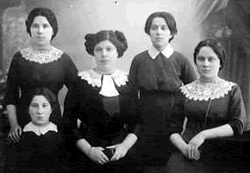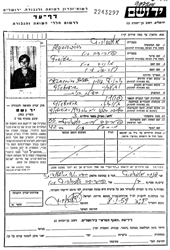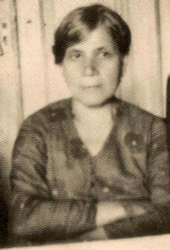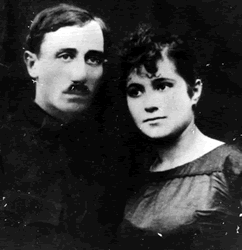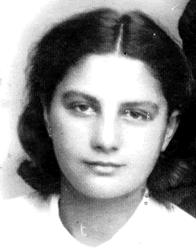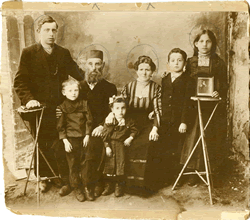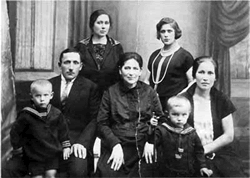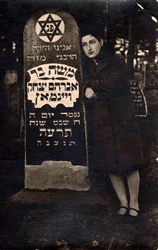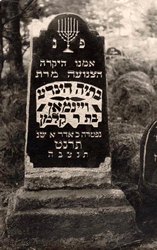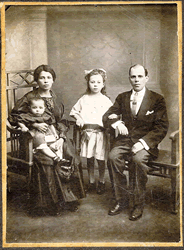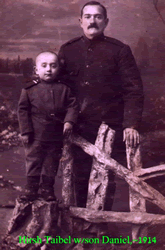Also known as Hlybokaye, Glebokie, Glubokoje, Glubok
Today; Belarus, 1944- 1990s The Soviet Union, 1921- 1939 Poland, pre First World War; Russian Empire.
#glu_1a A birthday party in Glubokie in 1932 |
#glu_1b Rabbi Solomon/ Shlomo Bogin with wife, daughter Sonia and son. |
#glu_1c Meir Bogin and family 1934. |
#glu_1d Masha (nee Bogin) with husband Chavel and baby Senya. |
#glu_1e Glubokie gymnasia in 1935 |
#glu_1f kayaking in Glubokie before the war |
#glu_1g Leah (nee Bogin) with friends. Glubokie, 1930 |
#glu_1h Schoolmates in 1936 |
#glu_1i The Bogin children c 1930 |
|
#glu_1a Students organization of the Jewish school of Glubokie. |
#glu_2b the Mandolin orchestra of Glubokie |
#glu_3 The soccer team "Macabee of Glubokie" |
|
#glu_4 Members of "HeChalutz" ( Zionist Youth) in Glubokie in 1931. |
#glu_5 . The entire membership of HaChalutz in Glubokie. |
#glu_6 Sukkot in Glubokie in 1936 . |
|
#glu_7 A group of survivors next to the brotherly memorial for the Shoah victims. |
#glu_8 young people of Glubokie. |
#glu_9 A street in Glubokie |
|
#glu_10:Girls
in a class at an ORT trade school for seamstresses in the first
year that the courses existed. (Yiddish sign on wall) "May
good fortune come to the hands and forehead from which sweat pours."
1923.
|
#glu_11: Studio portrait of the four Ceitel sisters with a cousin. 1913. My grandmother Rebecca's four younger sisters, Zelda (Zhenia), Miriam (Mania), Braine (Berta) and little Chana (Ania). My grandmother had already immigrated ( prior to 1913) to the United States with her husband and youngest son, my father . She never again had contact with her sisters who remained in Poland (Russia), but after the fall of Soviet Russia, her descendents renewed contact with her sisters' descendents - Janice Kaufman |
#glu_12:
Jewish grain dealers pose on a cobblestone street, conversing
amid their wares.
|
|
#glu_13:Dov
Boris Katsovitsh Birth; Glubokoye, 10/6/1923 Holocaust Period; Area of Combat; Vilejka Unit Battalion Hanokem (Mstitel) |
#glu_14:Avner
Fejglman (Feyglman) Birth; Glubokoye Nickname Alosha Area of Combat Narotsh Forest Unit Battalion Tshapayev Resistance Organization Local Underground Job Group Commander |
#glu_15Michael
Etkin Birth;Glubokoye 25/12/1932 Holocaust Period Combat Glubokie Forests Battalion Kutovski Job Watchman |
|
#glu_16:Ayzik
Bodnyov born in Glubokoye /8/1904 Partisan Battalion Zhukov Date Of Death 23/12/1975 |
#glu_17:Icchak
Blat was Born in Glubokoye in 1919. He was a partisan; Battalion Tshapayev, Patrol Commander. Died in combat 1/2/1944 |
#glu_18: Zalman
Ber Kotz and wife Luba. Taken sometime in 1944-45 while he was |
| #glu_19: A printing shop in the Glebokie (Glubokie) ghetto. |
#glu_20: Chava Etkin nee Kaminski was born in 1915 to Israel and Mikhaela. She was a nurse in the Glubokie hospital and married to Mendel ( he died in 1941). Prior to WWII she lived in Krolewszczyzna, Poland. During the war was in Glebokie, with her two sons ( Chaim Shabtai and Michael both born 12/ 1932). Chava escaped and joined the partisans in 1943. She was killed in June of 1944 at the age of 28. Testimony submitted by her survivng son; Michael Etkin. |
#glu_21: |
| #glu_22: At the home of Moshe, the blacksmith (Kreines) on 75 Vilna Street was the wagon factory, which was supervised by a Motl Berchov from Luzshki. they assembled wagons, wheels, sleds and alike for the Wehrmacht (German Army). In this "wagonbau" the Jews suffered greatly from the White Russian, Valakevitsh, a member of the "Council of White Russia" of Astravskes clique in Minsk. Valakevitsh was the steward of the "wagonbau" and by his torture of Jews and incitement to pogroms was very pleasing to the Germans |
#glu_23: there was to be found the men's tailor and furrier in Sarah Kremer's home (the wife of the teacher, Zalman Kravietz) This workshop was directed by Miakinin. There worked there some dozens of tailors, among them: Zelick Glazman, Zalman Feigelson, husband of Feitze, Arke, the shamash of the blue Minyan, Shlomo-David Pren, Ettingaff and others. They would skillfully make fine warm fur gloves and so forth |
#glu_24: Jewish men and wormen workers in a laundry in the Glebokie (Glubokie) ghetto. |
| #glu_25: Entire plantations were established in the Jewish gardens,. All sorts of hops were planted as well as other growing things. Someone named Katz, from the town of New-Svientzian supervised this. About 40 Jews worked the plantations. Later they were bit by bit eased out of this work, and Poles and White Russians replaced them. The Germans exploited the talents of Moshe Mirman, and therefore let his wife continue to work there. Also Leib Krivitzky, Sharke Sragavitsh, Tzilye Mirman and others worked there. |
#glu_26: Lea Kamenski was killed in the Glebokie (Glubokie) ghetto in August 1943. Chava Etkin served as a nurse in a partisan unit in Belorussia; she fell in 1943. |
#glu_27: Even the very young children worked. For them, the infants, e a workshop was organized. They made cartons, so that the Germans would be able to pack the things that Jews made, and send them to Germany. The 11-year-old cripple, Yashe Mazavetzky, the grandson of Yerachmiel Alperovitsh, supervised this workshop. In that place there also worked the 7 year old Zinke (Aaron-Yitzhak) Raiak |
| #glu_28: the shoemakers-workshop was to be found in the house of Mrs. Linushkin, sister-in-law of Shimon Lekach,. David Drutz from Hoifisher Street, who was the son-in-law of Eli the Shamash (Beadle), supervised this enterprise. There, there worked: Chanan Meltzer, David Weiman, Zalman Shitzkin and others. Also fictious "shoemakers" worked there. The former teacher, Kasriel Shneidman used to make wooden slippers. And Lipa Landau, (son of the Rabbi of Droisk, and also ordained), learned to sew a pair of boots there. The shoemakers were flooded with work, always had orders from the Germans, who would send shoes to Germany for their relatives, and also use them for trade. |
#glu_29: A knitwear establishment opened at the Shulvitsh's home. many women would knit sweaters, gloves, socks, hoods and other things There. Girls, as young as 8, also worked there. All told there were about 60 to 70 women who worked there. |
#glu_30: Ladies tailoring establishment run by Hannah Knel operated at Kasriel Kotz's home on Vilna Street. They sewed for the German women. The seamstresses used to have to go measure the garments for the German women, and this was dangerous. The first worry was whether or not the German woman would approve of the work and not feel that the Jewish seamstress had not put her heart and soul into the work on her dress, or slip… It was not less dangerous to pass through, to and from, the entire city, outside of the Ghetto. The manager, Hannah Knel, whose duty it was to go and do the measuring or bring the finished garment, would, bid farewell to her fellow workers every time she left, and they would wish her a safe return… |
#glu_31: |
#glu_32: On Vilna Street, in the home of Shimon Lekach, there was a stamp press, under the supervision of Mendel Galberstein. In that place, there worked about 20 stitchers, among whom there were: Hirsh Izraelov, Yitzhak Shuchman and his brother, Shimon Lekach, Gurevitsh, a young man from Dakshitz, Avraham Budav and others. They would stamp out the heels of shoes and boots, and also leather portfolios, holsters for revolvers, satchels and so forth. They would also stamp out for the German women, bolsters and all sorts of slippers. The work would turn out very nice and artistic. The Jews did it in good taste, and the Germans were pleased with the work. |
#glu_33: |
#glu_34: Chain Chana Fidelholtz with his daughter Dina. |
#glu_35: Rachel Fidelholtz ( nee Nuhous?) with daughter Dina. |
#glu_36: Anna Andzia Chana Mirski / Glubokoye, Belarus / Pabrade, Lithuania |
| #glu_37: Chaim - Szabtaj and Mikhael, the sons of Mendel and Eva Etkin |
#glu_38: Members of the He - Chaluts ha - Tsa'ir youth movement in Glebokie (Glubokie). |
#glu_39: members of HaChalutz HaZair in Glubokie |
| #glu_40: Women and girls working at hand - knitting, in a knitting workshop in the Glebokie (Glubokie) ghetto. |
#glu_41: Jewish workers in a signpainting workshop in the Glebokie (Glubokie) ghetto. |
#glu_42: Workers in a printing shop in the Glebokie (Glubokie) ghetto |
| #glu_43: Jewish workers in a small factory for making oil in the Glebokie (Glubokie) ghetto. |
#glu_44: Jewish workers in a small factory for making oil in the Glebokie (Glubokie) ghetto. |
#glu_45: Jewish workers in a small factory for making oil in the Glebokie (Glubokie) ghetto. |
| #glu_46: Jewish workers in a tannery in the Glebokie (Glubokie) ghetto. |
#glu_47: Jewish workers in a spinning mill in the Glebokie (Glubokie) ghetto. |
#glu_48: Jewish workers in a spinning mill in the Glebokie (Glubokie) ghetto. |
| #glu_49: Jewish tailors in a workshop manufacturing men's garments in the Glebokie (Glubokie) ghetto |
#glu_50: Jewish women working in the ironing department of a tailoring workshop in the Glebokie (Glubokie) ghetto. |
#glu_51: Jewish seamstresses in the women's garments department of a tailoring workshop in the Glebokie (Glubokie) ghetto. |
| #glu_52: Jewish seamstresses in the Glebokie (Glubokie) ghetto, in the finished garments storeroom of a factory for women's wear. |
#glu_53: Jewish seamstresses in the Glebokie (Glubokie) ghetto, in the finished products storeroom of a garment factory. |
#glu_54: Jewish seamstresses in the finished products storeroom of a garment factory in the Glebokie (Glubokie) ghetto. |
| #glu_55: Jewish seamstresses in the Glebokie (Glubokie) ghetto, in the finished products storeroom of a workshop manufacturing hats. |
#glu_56: Jewish workers in a workshop manufacturing hats in the Glebokie (Glubokie) ghetto The cap makers organized a workshop in the Ghetto to make hats. Eli Alai, Reuven Gordon, Chaim-David Rothenberg - a Hassidic Jew from Lomzsher Street and others worked there. |
#glu_57: Jewish youths in the finished products storeroom of a workshop manufacturing felt boots in the Glebokie (Glubokie) ghetto. |
| #glu_58: Jewish women working in a workshop for manufacturing shoe polish in the Glebokie (Glubokie) ghetto. |
#glu_59: Jewish workers in a workshop for manufacturing mattresses in the Glebokie (Glubokie) ghetto. |
#glu_60: Jewish workers in a carpentry workshop making furniture in the Glebokie (Glubokie) ghetto. |
| #glu_61: Jewish workers in a tin smithy in the Glebokie (Glubokie) ghetto. |
#glu_62: Jewish workers in a metalworking shop in the Glebokie (Glubokie) ghetto. |
#glu_63: Jewish men and wormen workers making flowerpots in a small factory in the Glebokie (Glubokie) ghetto. |
| #glu_64: Members of the "Shachariya" pioneering training commune (kibbutz hachshara) of the He - Chaluts movement division in Glebokie |
#glu_65: Members of the "Shachariya" pioneering training commune (kibbutz hachshara) of the He - Chaluts movement division in Glebokie in 1933 |
#glu_66: Members of Hachalutz in Glubokie in 1932 |
| #glu_67: Chajka Berg, a member of the He - Chaluts movement, from a Zionist pioneering training unit in Glebokie |
#glu_68: Jewish children working in a shoemaker's workshop in the Glebokie (Glubokie) ghetto. |
#glu_69: Young members of the Revisionist movement (Bitar) in Glebokie |
| #glu_70: Rajak of Glebokie (author of the Yizkor book) is pictured here in a Vilna meeting of Zionists. ; |
#glu_71: The synagogue |
#glu_72: |
#glu_73: |
#glu_74: A street in Glubokie ( pre 1939) |
#glu_75: |
#glu_76: |
#glu_77: Glubokie 1934, the rebe visits |
#glu_78: Frejda Alperowicz nee Alperovitz was born in Kurzeniec, Poland in 1888 |
#glu_79: Pesia and Zorach. |
#glu_80: Shifra Kil was born in Dolhinow in 1922 to Zerakh Norman and Peshe nee Katz (they also perished). . Shifra perished in 1943 in Glubok,with husband Barukh Kil. This information is based on a Page of Testimony submitted by her GRANDMOTHER who survived Breina Katz nee Yafe. |
#glu_81: Thank you, I have gotten so much out of reading your website. Here is a family photo from Globokie taken approx. 1911. The patriarch is my great-grandfather Shepsel Fleisher. The teenager at the right is my grandmother, Jennie Margolies nee Zelde Fleischer.david@marklawoffice.com David Mark |
#glu_82: Recently in the process of working on the inventory of the Jewish cemetery in Glubokoe, one of the oldest tombstones was discovered. The tombstone is for Shneur Zalman and dated 1708. This matseiva is the oldest one among all known burials in the northern part of Belarus. |
#glu_83: The Feigelson family. Leonard Felson’s father on left. |
#glu_84: My 2nd great aunt, Malke Vaynman-Arons with the headstone of her father Moshe Vaynman. The 2 photographs that were supposedly taken at the Jewish Cemetery in Glubokoe in February of 1934. |
#glu_85: The headstone is that of Moshe’s 1st wife, Basya-Hinda Kunkes, daughter of Kalman. |
#glu_86: Notel Esterovich, his wife and children; Shalom and Rivka, in Vilna 1910. Notel and his wife perished in the Glubokie Ghetto. The family lived in Kaziany before and during the war . The children survived ( lived in Israel) |
#glu_87: Chai Freide Feigelman nee Feigelzon was born in Disna, Poland in 1875 to Yaakov and Ester. Prior to WWII she lived in Glebokie, Poland. During the war she was in Glebokie, Poland. Chai freide Feigelman was murdered in the Shoah. |
#glu_88: Sara Mina Feinshtein nee Figelman was born in Glebokie, Poland in 1901 to Simkha and Khaia. She was married to Alter. Prior to WWII she lived in Glebokie, Poland. During the war she was in Glebokie, Poland. Sara mina was murdered in the Shoah. This information is based on a Page of Testimony (displayed here) submitted by her sister, Shifra Argov |
#glu_89: Alter Feinshtein was born in Smalensk, Russia (USSR) in 1905 to Feibush and Rakhel. He was married to Sara nee Figelman. Prior to WWII he lived in Gluboke, Poland. During the war he was in Gluboke, Poland. |
#glu_90: Sara Mina nee Feigelman, her husband Alter Finestein , daughter Bat Sheva born in 1930 and son Yerachmiel (Rachimka) born in 1936 in Glubokie. The entire family perished in the holocaust. Picture taken in 1939 submitted by Shifra Argov nee Feigelman, the sister of Sara Mina |
|
|
|
|
Created by Larry Kotz (son of Glubokie native, Zalman Ber Kotz) & by the Etkin family in Israel & by Eilat Gordin Levitan
Please share your comments or photos or links for posting on our Guestbook Page here: egl.comments@gmail.com
|
The
Disna Uyezd Research Group is happy to have made available to its
members translations of the 1850 Revision List for the shtetlach of Bildziugi, Disna, Druya, Germanovici, Glubokoye, Golubicy, Leonpol, Plisa, Postovy, Sharkovshina, finally Luzhek. Translations were sent to each member best regards,Batya Matzkin Olsen, Concord, Massachusetts USA http://www.jewishgen.org/jgff/jgff-faq.html#q3.7 |
|
Map
| Old Scenes | New
Scenes | Partisans
| Families
| Portraits
| Stories
| Letters
|Globoki Revision List Part
1, Part
2, Part
3 | Gluboyke Revision List 1850: A - G, G - Z | Glubokie Society New York | Memorials | Synagogues | Glubokoye Yad Vashem | Glubokie List of Perished | Glubokoye Archives | Shoah Foundation list | Documents |||||
|
This is a translation of the chapter "Glubokoje", Lite
(vol.1) Edited by: Mendel Sudarsky, and Uriah Katzenelenbogen,
New York: Jewish-Cultural Society, 1951, chapter on Glebokie, pp. 1551-1554
Glebokie
By Alte Arsh-SudarskyTranslated by Judie Ostroff GoldsteinI lived and
worked in Gluboke for a time before the First World War and during the
war and a lot of good memories have stayed with me.
As the name [from Slavic root meaning "deep"?] suggests, Gluboke
lay deep in mud. Some of the streets were not paved with cobblestones
and were so affected by the autumn rains that once a lady who was traveling
from a nearby courtyard on Bakshitser Street nearly drowned in the mud,
along with with her carriage and two horses harnessed side by side. The
entire shtetl came running with ropes to save the lady and her horses.
Still Gluboke was a nice shtetl with fine, caring Jews who felt the spirit
of their famous townsman Reb Shmuel Mohilover, z'l [may his memory be
blessed].
Besides the weeping autumn days, Gluboke also had wonderfully beautiful
spring and summer days with cool evenings when the young people would
go out for a walk after work to the kaponitze, which was a natural wonder.
It was a kind of small lake where smooth, regular little paths of dry
land with trees arose from the water so perfectly, that it was hard to
imagine they were not artificially planted. A water mill was located there
that made the entire area very beautiful and romantic.
I will never forget summer moonlit nights when the water was illuminated
as if by a magical light. The quiet would be disturbed from time to time
only by bird songs.
But in addition to the beautiful natural surroundings, Gluboke was blessed,
as I already said, with worthy families, with good, kind people who understood
this hard life in its broader significance. They were absorbed not only
in commerce and work, but in studying, charity and good deeds. They always
responded warmly to all the worries and needs of their fellows. When poor
Jews became sick, the better-off families looked after them with a doctor
and medicines, and also with a free loan when the situation warranted
it. From among these families, the Wolfsons were especially distinguished,
being rich and blessed with children (19 grown offspring!). Most of the
children studied in large Russian towns and when they gathered together
at home during vacations, it was very lively in the shtetl. They also
brought a revolutionary spirit to the shtetl, spreading the ideas of Socialism
and Zionism. The Schenker, Levitan, Zak, Friedman and Zeldin youth were
also like this. Political parties separated the young people, but affection
united them.
[Photograph with caption: Mendl
and Basia Zeldin and their children: Harry, Nakhum, Esther, Reuben and
Daniel. (Arrived in New York 45 years ago).]
Families large and small became united especially when, G-d forbid, an
unfortunate event took place. Thus if a family breadwinner had to go to
America to avoid conscription or to earn a livelihood, everyone understood.
One must handle whatever happened, only not succumb and not, G-d forbid,
allow a fellow Jew to succumb. If a nobleman or count would turn his wrath
loose on a peasant or gentile, these same Zeldins and Schenkers went to
the landowner to intercede so that the peasant's bit of land or harvest
would be spared.
* * *
Now, no where are they all, these good, pious and worldly Jews with their
children and their children's children? They met the same fate as that
of the neighboring Haidutzshiker, Lituper and Dukshter Jews, who in February
1942 were led out onto the ice on the once beautiful kaponitse, doused
with something flammable, and burned alive.
A Lithuanian Nazi newspaper "Lietauvos Apzhvalga"? afterwards
had an outrageously vile headline: "Jews in Gluboke Burned like Corn?"
But Jewish Gluboke, like many other towns, was nonetheless lucky that
over time many if its residents had wandered away to America and other
countries.
After many years of wandering I met one of them in America and memories
surfaced of the old homes of these Jews in Gluboke.
Standing alive before my eyes was the old man Reuben Zeldin and his wife,
the clever, hardworking, and charitable Esther Devorah. With a generous
hand and aching heart for everyone's grief she always served as an example
of self-sacrifice, and also continually inspired others to good deeds.
But good is its own reward. Their son Mendl and his wife Basia (nee Arsh)
followed the same path. When they had to leave for America during the
Japanese War in 1904-05, they received the other Gluboke Jews whom they
helped come to America like their own loved ones. As Mendl Zeldin thanked
them, so they responded in kind, yet they have still not paid the full
debt owed him for all his previous help.
As for the Zeldin family, their four sons (Harry, Nakhum, Reuben and Daniel)
and one daughter Esther (now Okun) grew up and became well-known dentists.
The eldest, Dr. Harry Zeldin, a famous surgeon, led a generous undertaking
to found and build a College of Dentistry at Jerusalem University.
And so our Jews carry on the golden era of their families from the old
country the era of Torah and good deeds.
picture;
http://data.avotaynu.com/wconnect/wc.dll?jg~jgsys~avotaynupc_pb~Glebokie
Original Title: Khurbn Glubok...Koziany
English Title: The destruction of Globokie...Koziany
Editor: M. and Z. Rajak
Published: Buenos Aires 1956
Publisher: Former Residents' Association in Argentina
 Pages: 426 Languages: Y
Notes: Translation - see "Memorial book of Glebokie"
UCLA Research Library, Los Angeles, CA, United States, Call No: DS 135
R93 G587

Original Title: Memorial book of Glebokie; a translation into English
of Khurbn Glubok
English Title: Memorial book of Glebokie; a translation into English of
Khurbn Glubok
Editor: M. & Z. Rajak
Published: Canton, NY 1994?
Publisher: Dr. Kendall Taylor (107 Main St., Canton, NY 13617)
 Pages: 180 Languages: E
BGN gives current name as Hlybokaye
Pictured; My grandfather; Hirsh, born to Leib Taibel of Glubokie, in
1881 with son Don/ Daniel
My father and I were natives of Kovno, Llithuania. I was sure that
the Taibel last name originate in Lithuania and the ancestry of my
father
lived in Lithuania for many generation. Until a few years ago, when I
received the marriege certificate of my grandparents, from the
Lithuanian
arcives. It said that the groom; Hirsh Taibel, was born in Glubokie.
I found a Glubokie list of natives on the net connecting my family to
the town of Glubokie ( Belarus). I am guessing that I am a descendant
of a "Don Taibel". Uncommon first name which repeated itself with my
fathers brother. I knew him as Daniel. I knew my grandfathers' sister
very well; Maria/ Martha Rom was born in 1892 and passed away in 1975.
My great grandfather: Taibel Leib- grandfather: Taibel Hirsh -
1887-1918
He married in 1906 in Kovno. Its children were born there .
He died in 1918, when my father was only 10 years old.
From: reuven taibel ruva11@gmail.com
Miriam Gindin Holzman miriamholzman@yahoo.
My father and his entire family were from Gluboyke. My dad (Hillel
Gindin) has always told us stories about "his little village". Can't
wait to
tell him what we just found on line! Thank you SO MUCH for all the
added
information that we now have. Miriam Gindin Holzman, Cherry Hill, NJ
Message: I am researching Chaya Temkin of Glubokae who married Yitzhak Sorkin
and moved to his town Plissa. Their daughter Shaina Sara, married Avraham
Yehuda Berzon from Germanovich and moved to Plissa. They had 4 children, one
being my father Rabbi Bernard ( BeryLeib ) Berzon and they moved to Akron Ohio.
I was wondering if there are any readable gravestones still existing in
Globukae, Plissa and Germanovich. Perhaps, they are organized in lists; so
stones can be readily found and read.BTW these three shtetlich are within 30 km
of one another.
WE can be emailed at : cmb@bezeqint.net
Thanks,
Rabbi Chananya Berzon
«KADISH» IN GLUBOKOYE
http://shtetle.co.il/Shtetls/glubokoe/glubokoe_eng.html
go to the bottom of the page to see the video

The Etkins in a museum in Glubokoye. Photo taken in 2009.
Two brothers were standing in front of a memorial dedicated to Jewish residents of the ghetto in Glubokoye, executed by fascists. They were saying a memory prayer. In one of these ditches lie the remnants of their relatives: the Etkins and the Kaminskys. I cannot say how many generations of these families used to live in Belarus but they spread their roots here: started families, gave birth to children, built homes, mills and dreamt about the future of their descendants. And even in the worst nightmare they could not imagine that there would come a day when all of this would be taken away from them.
Mihael Etkin was the only one to survive from the whole family. He can tell the story of the tragedy of his family and all the European Jews.
Mihael Etkin escaped from the ghetto. At that time he was ten. He fought in a partisan detachment; then lived in an orphanage in Vilnius. Later he moved to France and in the end - to Israel. He studied, worked and started a family. He has five children, thirteen grandchildren and a great-grandson.
Mihael always wanted to come to Belarus, see the country, where his ancestors lived and where he spent his early life. He wanted to find out what had happened to his mother, where her grave was.

House in Krulevshizna. Photo of the family in front of the house.
As soon as Glubokoye district was liberated in 1944, Mihael Etkin started looking for his mother – Eva Kaminsky. He hoped that she was alive and looking for him. Once, he met a soldier, who asked him: “Are you Eva Kaminsky’s son?” Then he added: “Your mother was a heroic woman.” He said nothing else, so Mihael did not know what actually had happened to her.
Mihael wrote a letter to a newspaper in Glubokoye, asking if anyone remembered Eva Kaminsky, a partisan nurse. There were no answers. The staff of the Belarusian Embassy in Israel found out about Mihael and decided to help him. They received a letter from the Belarusian archives: Eva Kaminsky was executed by fascists in Dokshitsy together with other partisans.
Mihael, despite health problems, made up his mind to come to Belarus.
… He had a twin brother, Haim. One of Mihael’s sons is called Haim now. He came to Belarus together with his father. Mihael’s mother originated from Glubokoye, father – from Krulevshizna. His name was Menahem-Mendl Etkin. They owned a mill and a saw-mill. Even though mother also had a good job, working as a nurse in a hospital in Glubokoye, they decided to live in Krulevshizna. So Eva took a train to work every day.

The Etkins. Standing from left to right:
Eva (Hava) Kaminsky-Etkin, father’s uncle Hanoh Etkin, his wife,
Hanon Perevoskin (aunt Rahel’s husband),
Boma Kabakov (cousin, who came from Israel to visit the family),
father’s aunt Rahel Etkin. Sitting: grandmother Haya-Liba Kabakova
and grandfather Saul-Rafael Etkin.
At the bottom, from left to right: Mike (Zelik)Hodosh (father’s cousin),
my father Mihael Etkin, his twin brother Haim-Shepse Etkin
and Greg Hodosh (Mike’s brother).
Photo taken in 1935.
Mihael Etkin did not come to Belarus in the end. He died in February, 2009. His plan was carried out by his sons Haim and Menahem. They came to Belarus with their wives and one son. In Krulevshizna they found the place where their house once stood, where the mill and the saw-mill were located. Of course, that place was different and nothing showed that it had gone through the war.
Then there was a trip to Dokshitsy. Archive documents mention that here, on the central square, there was a gallows, where fascists hanged partisans, where they also hanged the nurse Eva Kaminsky.
Dokshitsy does not have a Jewish cemetery. Old matseivas were scattered in a place, where Jews were once buried. Several years ago a symbolic Jewish cemetery was made by American Jews, whose roots originated in Dokshitsy. The matseivas were collected and set up in one area, which was fenced. The Etkins set up “a virtual memorial” to Eva Kaminsky in the same area.

Memorial at the place of liquidation of Glubokoye ghetto. Photo taken in 2009.
Mihael often told his children and grandchildren about the country they had never been to. Many things sounded odd to them, but when they grew up, they understood his feelings. He especially loved talking about his mother, who was a widow with two small children. Her husband died at the age of 32 in 1941. Of course, the big family helped her raise the children.
When Nazis came to Krulevshizna and Glubokoye, life changed abruptly.
In October 1941 Germans and local policemen deported all the Krulevshizna Jews to the ghetto in Glubokoye. Eva decided not to wait for better times – she joined a partisan detachment and left her two sons with sister Leya.
In August 1943, when the liquidation of the Glubokoye ghetto began, Leya was with her two nephews, not knowing what to do. She was not as decisive as her sister. Mihael tried to convince her to escape but she would not agree: “We will have the same fate as everyone else.” Then Mihael dashed in the direction of the forest. He was wounded on the leg and fell down. Fortunately, a man named Motka helped him. He took him to the forest and put bandage on the wound. Mihael had to walk from village to village and beg for food and lodging. A Belarusian family sheltered him in one of the villages. Mihael tried to find them after the war but failed.
The family took care of Mihael and treated his wound. Once Germans entered the house and saw the boy on the bed. They asked who he was. The family said he was ill with typhus and it was dangerous to approach him. They claimed the boy was their worker. The Germans left the house immediately. It was dangerous to stay in the village and Mihael was sent to a partisan brigade.

Attachment of a memorial tab to all the executed members
of the Etkin family. Photo taken in 2009.
I met the Etkins in Glubokoye. We came to the memorial, dedicated to the people, executed in the ghetto. Mihael’s daughter-in-law, Mazal, read a letter, which they wrote to Eva Kaminsky.

Memorial at the place of liquidation of Glubokoye ghetto.
Photo taken in 2009.
“We never knew you personally and never heard your voice. Only owing to Mihael, who told us a lot about you, we remember your name. Only the two photographs, which we have, show your beautiful face. One of the photographs was made in front of your house, where you are with your husband and the two boys. Mihael often remembered that day, the house, even the smell of the apples from the orchard.
Following your duty, you joined the partisans, leaving the children with the sister. Your profession showed you the way and became your destiny. You realized that you had to fight and help people. Mihael always wanted to be with you. You were aware of that and once wrote him a letter: “Dear son! I will meet you one day. This happy moment is sure to come.”
We want to tell you the story of your family, which followed. Your son survived the war. He was helped by kind people. He lived in an orphanage, a repatriates’ camp and ended up in Israel. There he built a house, started a family and raised children. Until the end of his life he continued looking for you. He did not manage to do it; that is why we are here. Please, forgive us that we have not found your grave…
We are here to share this story with the following generations.”
The Etkins and Glubukoye are separated by thousands of kilometers and numerous borders, but there are memories that unite them and make them understand each other better.
Arkady Shulman
2009
